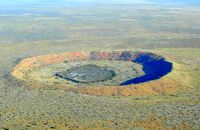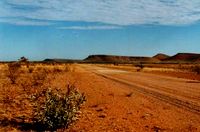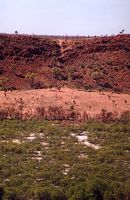Wolfe Creek Australia
Wolfe Creek Meteorite Crater National Park
The Wolfe Creek Crater in Outback Australia used to receive very little attention from travellers, the tourism industry and the media.
Well, didn't that change!
At the moment the meteorite crater gets more publicity than any other national park in Australia.
But the jury is still out on whether that's good or bad publicity for us West Australians...
 Read more about the movie and the Wolf Creek murder in Wolf Creek: The True Story
Read more about the movie and the Wolf Creek murder in Wolf Creek: The True Story
Good or bad, the movie has generated huge interest in the remote Kimberley region and the Wolfe Creek Crater National Park.
On this page you can:
- Read about the meteorite impact that caused the Wolfe Creek Crater
- Find travel information for Wolfe Creek Australia National Park
Wolfe Creek Crater
 Wolfe Creek in Australia was formed by a giant meteorite that crashed into the earth 300,000 years ago. The 50,000 tonne meteorite impacted with a speed of 15 km a second (!), leaving the second biggest crater in the world from which bits of meteorite have been collected. The crater measures 880 metres across.
Wolfe Creek in Australia was formed by a giant meteorite that crashed into the earth 300,000 years ago. The 50,000 tonne meteorite impacted with a speed of 15 km a second (!), leaving the second biggest crater in the world from which bits of meteorite have been collected. The crater measures 880 metres across.
I'd say the forces and the event are well beyond our imagination...
A lot of the immense energy of the impact was instantly converted into heat. They melted, pulverised and atomised the meteorite itself and the ground underneath, deformed rocks and shot debris everywhere.
The crater that was left was probably about 120 metres deep. Over the next 300,000 years the wind gradually filled it with sand and today the Wolfe Creek crater floor is 50 to 60 metres below the rim, which rises 25 metres above the surrounding flat desert land.
Evidence of the impact, other than the crater itself of course, can be seen everywhere. Fragments of iron meteorite have been found kilometres from the crater. The western slopes of the crater and the floor are littered with more iron meteorite: rusty balls, some of them fused to the rocks.
Wolfe Creek meteorite crater was discovered during an aerial survey in 1947, and scientists have intensively studied the crater. But the Djaru Aboriginal people, the original inhabitants of the area, have known the crater for thousands of years. They call it Kandimalal and have their own dreamtime story about its creation:
Two rainbow serpents formed Sturt and Wolfe Creek as they crossed the desert, and Kandimalal is the place where one of the serpents emerged from the ground.
Wolfe Creek Australia National Park
Wolfe Creek Australia National Park is located on the southern end of the Western Australia Kimberley region, on the border to the Great Sandy Desert and Tanami Desert of northern central Australia.
To visit Wolfe Creek you will drive to Halls Creek on the Great Northern Highway. If you visit the Kimberley coming from Darwin you will reach Halls Creek 358 km (222 miles) west of Kununurra. The distance from Broome to Halls Creek is 686 km (426 miles).
From Halls Creek you travel for another 145 km (90 miles) on the unsealed Tanami Road and the park access road. The gravel road can be used by normal cars (non four wheel drive, 4wd) during the dry season, May - October.

But be aware that it can be pretty rough and the sharp rocks are dangerous for your tyres. The corrugations (ridges and dints that make the road look like corrugated iron) can be hard on your bones and shake your car to bits, so if you go in a normal car go slow! You should allow two to three hours for the trip, more if you're not in a 4wd.
The country you are driving through consists of flat desert plains, dotted with occasional trees and clumps of spiky spinifex grass. The endless open space has a mesmerising beauty... and makes the striking formation of the Wolfe Creek crater stand out even more.
You won't find many tourist facilities at the crater. There is an information shelter, picnic facilities and a basic capsite with bush toilets. No water is available! Please make sure you bring enough. Keep in mind that the desert climate is very dehydrating, even if you don't feel the heat as much as in the humid tropics.

You can go exploring and hiking along the crater rim and enjoy magnificent views that stretch to the end of the world, or so it seems. There is also a track down to the crater floor.
The Wolfe Creek crater developed its own little eco-system after the meteorite impact. The nature of the soil and rocks inside the crater is different from the surrounding desert, the ground is more porous and the rim offers some shade. A rare thing in the desert...
Wolfe Creek crater supports reasonably large trees and an interesting variety of wildlife.
The rocks along the rim contain the moisture underneath, and many flowering shrubs take advantage of this. The best time for nature observations and taking photos is, as usual, the early morning and late afternoon. Most animals will hide during the heat of the day, and the harsh light would make your photos look flat.
If you'd love to see the crater but aren't interested in hiking, or if the idea of the long drive puts you off, you can view Wolfe Creek Australia National Park from the air, on a scenic flight out of Halls Creek.
Wolf Creek: The true story about the Australian Outback murder.
More about the Kimberleys in Western Australia
Read about other National Parks in Australia
Australian National Parks Site Map
Return to Outback Australia Travel Guide home page





